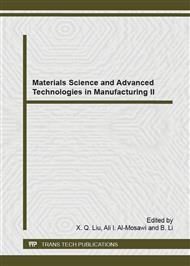p.3
p.7
p.11
p.16
p.20
p.25
p.31
p.38
p.43
The Preparation and Phosphate Adsorption Experiments of New Modified Bamboo Powder
Abstract:
The bamboo processing residues, as raw material, was modified by quaternary ammonium to obtain a quaternary ammonium modified bamboo powder adsorbent. The phosphate’s adsorption capacity of the powder adsorbent was investigated. In addition, the effects of dosage, pH, time, temperature, initial concentration on phosphate’s adsorption capacity. Then, the research performed the adsorption isotherm model fitting. The results showed that the adsorption rate of modified bamboo powder to phosphate increased with increase of dosing amount of modified bamboo powder, tended to be equilibrium when the removal rate reached to 97%; while the phosphate with high initial concentration could improve the adsorption capacity of modified bamboo powder. In acidic condition, the modified bamboo powder presented unsatisfied adsorption effect on phosphate, when pH= 6 the adsorption effect become well, but adsorption effect did not vary apparently with the increase of pH. With the increase of temperature (25, 35, 45°C), the maximum saturated adsorption capacity of modified bamboo powder gradually reduced. The adsorption of modified bamboo powder on phosphate was a rapid process, which could reach equilibrium status within 50 minutes. The bamboo powder before and after the modification was conducted IR element analysis, the values before modification are N=0, C=45.54 and H=6.03; while after the modification, the values are N=2.65, C=40.33 and H=6.79, it is concluded that the nitrogen content of modified bamboo powder increase obviously and the quaternary ammonium can well be grafted.
Info:
Periodical:
Pages:
20-24
Citation:
Online since:
December 2014
Keywords:
Price:
Сopyright:
© 2015 Trans Tech Publications Ltd. All Rights Reserved
Share:
Citation:


